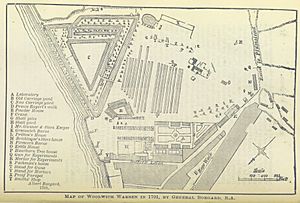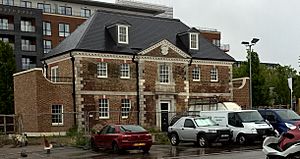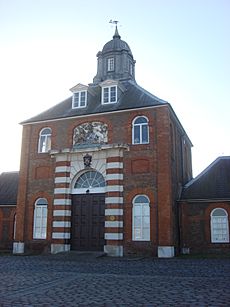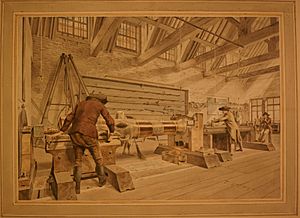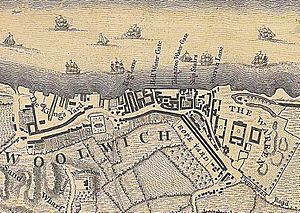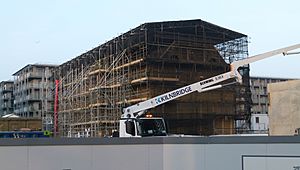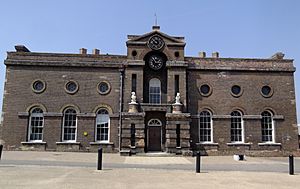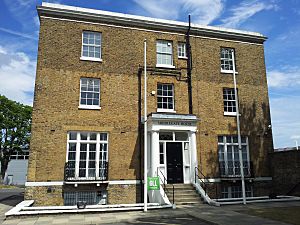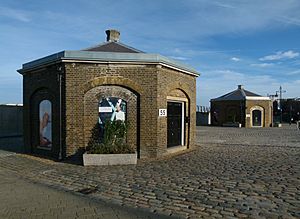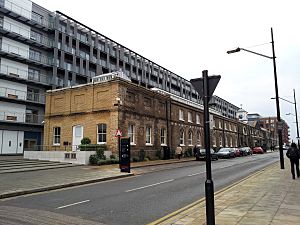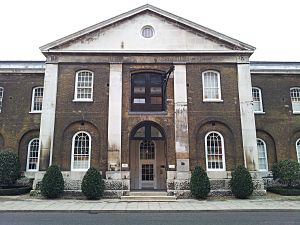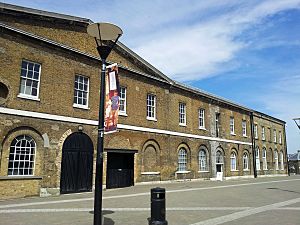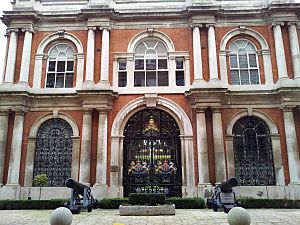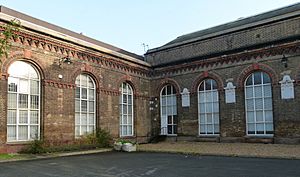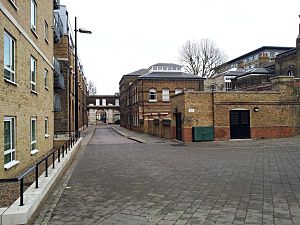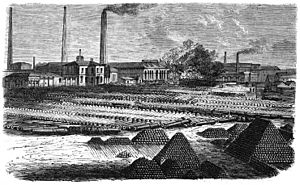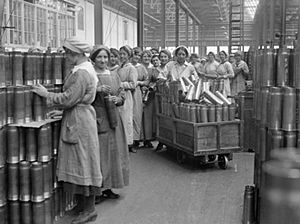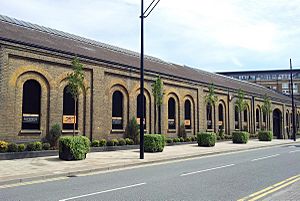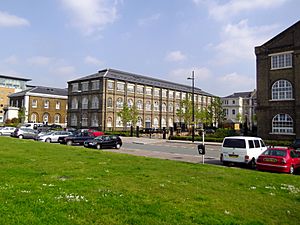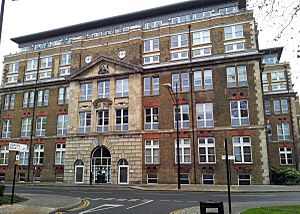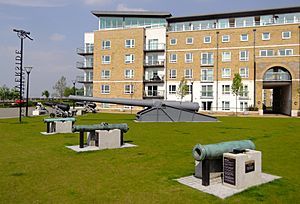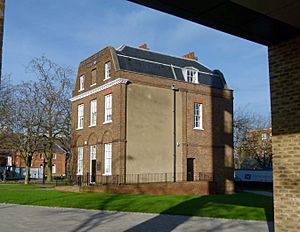Royal Arsenal facts for kids
The Royal Arsenal, Woolwich was a huge factory and research center in Woolwich, south-east London. It was located on the south bank of the River Thames. For hundreds of years, this place made weapons, ammunition, and explosives for the British armed forces. It also tested these items to make sure they were safe and worked well.
The Royal Arsenal started small, on land that was once a hunting ground for rabbits. It grew massively over time. By the First World War, it covered a huge area and employed nearly 80,000 people. After that, its operations became smaller. The factory finally closed in 1967, and the Ministry of Defence left in 1994. Today, this area, which was once a secret military site, is open to the public. It is being redeveloped with new homes and community spaces.
Contents
Early Beginnings: Gun Wharf and Tower Place
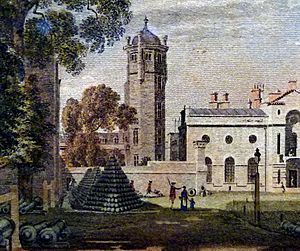
The Royal Arsenal began at a place called Tower Place in Old Woolwich. This area was originally a hunting ground. Tower Place was a large Tudor house built in the 1540s. It belonged to Martin Bowes, a rich goldsmith and merchant. He later became the Lord Mayor of London.
The house was near Gun Wharf. This was the original site of Woolwich Dockyard. A famous ship, the Henry Grace à Dieu, was built there around 1515. After the Dockyard moved in the 1540s, Gun Wharf was used by the Office of Ordnance to store guns.
In 1651, the owners of Tower Place allowed the military to test their guns on their land. The first testing areas, called "butts," were built there that same year.
Buying the Land
In 1667, after an attack on the Medway River, a gun battery was built at Tower Place. This battery, called Prince Rupert's Battery, was meant to defend London. The next year, Sir William Pritchard bought Tower Place. He then sold it to the Board of Ordnance.
In 1671, the 31-acre estate was given to the Board of Ordnance. They traded it for Gun Wharf and a lot of money. The Board said it was "a convenient place for building a storehouse for powder and other stores of war." Captain Francis Cheeseman became the first Storekeeper in 1670.
Testing and Experiments
In 1681, King Charles II visited the Warren. He watched an experiment with heated cannonballs. In 1682, the Board's main testing ground near the Tower of London closed. All its staff and activities moved to Tower Place. A thousand cannons and ten thousand cannonballs were sent to Woolwich from the Tower that year.
In 1683, the Board of Ordnance was officially set up. Two Proof Masters were appointed to make sure tests were done correctly. In 1684, the King visited again. He saw a trial of a new mortar design.
Storing Military Supplies
In 1688, an order was given to move all guns and supplies from Deptford Dockyard to Woolwich. From then on, new cannons and carriages were to be stored there. No manufacturing happened yet, except for making fireworks for special events. Saltpetre, a key ingredient for gunpowder, was refined here between 1681 and 1694.
Over time, the entire site became known as The Warren.
The Warren in the 1700s
The Board of Ordnance was a government office that handled both civilian and military matters. It was separate from the Army. Both parts of the Board worked at the Warren. Military officers often led the civilian departments, and civilians worked alongside military staff.
Civilian Departments
For most of its history, the Warren had four main civilian departments:
- The Storekeeper's Department: This managed all kinds of military supplies.
- The Royal Laboratory: This made all types of ammunition.
- The Royal Brass Foundry: This made cannons and was later called the Royal Gun Factory.
- The Royal Carriage Department: This made gun carriages.
Testing areas were also kept for testing guns and new ammunition.
The Storekeeper's Department
The Warren was first set up as a place to store military supplies. An official called the Storekeeper managed the site. He lived in Tower Place. The Storekeeper was in charge of receiving, keeping safe, and giving out all items. He also paid all the staff until the early 1800s.
At first, much of the Warren was open space. Cannons were stored outside, and guns were tested in ranges to the east. Gunpowder was stored in a converted dovecote. Soon, special buildings were built for storage.
The Royal Laboratory
An ammunition workshop, called a laboratory, was set up at the Warren in 1695. It was overseen by the Comptroller of Fireworks. Ammunition used to be made at Greenwich Palace. But in 1695, Greenwich Hospital began construction there. So, the workshop moved to Woolwich.
In 1696, Laboratory Square was built for its operations. This included making gunpowder, shell cases, fuses, and paper gun cartridges. The work was done by hand. Early paintings show workers making shells. Two pavilions, which are the oldest buildings on the site, are still there today.
The Comptroller of the Royal Laboratory also oversaw the Royal Gunpowder Mills. The Royal Laboratory often put on official fireworks displays for special events like coronations.
The Royal Brass Foundry
A gun foundry was built in 1717. It was overseen by a Master Founder. The Board of Ordnance decided to build its own foundry after a big explosion at a private foundry they used before. The original Royal Brass Foundry building in Woolwich is still standing. It was designed to be very practical for making cannons.
Finished guns were taken through what is now Dial Arch to be completed and stored. Behind the archway was a courtyard where guns were finished. Beyond that, two large gun-carriage storehouses stood.
The first Master Founder, Andrew Schalch, worked for 54 years. In 1770, a new horse-powered horizontal boring machine was installed by his successor, Jan Verbruggen. This machine inspired Henry Maudslay to improve the lathe. It was used until 1843.
From 1780, a new official, the Inspector of Artillery, oversaw the Royal Brass Foundry. He also managed carriage-making and gun testing.
The Carriage Works
From the beginning, gun carriages were stored at the Warren. The first store was built in 1682. It probably also had workshops for repairing old carriages. In 1697, a much larger complex of sheds was built.
By the 1750s, gun carriages were also being made on site. This work was formalized in 1803 as the Royal Carriage Department. This showed how important good carriage design and making were for military supplies.
Military Presence
By 1700, the Board of Ordnance had 20 gunners at the Warren. They helped make and test cannons. Civilian workers also helped with building and repairs. There was little difference between military and civilian staff at this time.
The military side of the Board of Ordnance grew stronger in 1716. Two companies of artillery and a group of military engineers were formed permanently. This was the start of the Royal Artillery and the Royal Engineers. Both groups had their main offices at the Warren for a while.
The Royal Artillery Regiment
The two artillery companies were based at the Warren. By 1722, they were formally named the Royal Regiment of Artillery. These troops helped with work on site and provided security. In 1719, they got their own barracks.
After 1716, the Royal Artillery took over gun testing. Testing guns became part of their routine training. A gunnery practice range was set up in 1787.
The Corps of Engineers
In 1717, the Engineer Corps grew to fifty officers. They worked under the Board of Ordnance. In 1787, the Corps was renamed the Corps of Royal Engineers.
At first, civilians were hired as workers. But in 1787, the Royal Military Artificers were formed. These were non-commissioned officers and men under the Royal Engineers. From 1795, both groups were based at the Warren. They designed, built, and maintained buildings and wharves at the Arsenal.
The Royal Military Academy
In 1720, the Board wanted to create a military academy for its Artillery and Engineer officers. A new building was put up where Tower Place used to be. This building housed the new academy and a Board Room.
The Royal Military Academy, Woolwich officially started in 1741. Its cadets later got their own barracks in 1751, which were demolished in the 1980s.
The Royal Military Repository
The Royal Military Repository was an offshoot of the Academy. In the 1770s, Captain William Congreve built a "Repository for Military Machines." This building showed cannons and mortars. The open space was used for training to handle large artillery.
The Ordnance Field Train
In 1792, as Britain faced war with France, the Board of Ordnance created a Field Train department. This group made sure guns, ammunition, and other equipment were supplied to soldiers. This small group was based at the Arsenal.
Military Moves to Woolwich Common
By the 1770s, 900 artillerymen lived at the Warren. This led to building new Royal Artillery Barracks on Woolwich Common. They moved there in 1777. Their old barracks were then turned into houses.
The Royal Military Repository was destroyed in a fire in 1802. But it was soon rebuilt near the new Artillery Barracks. Its items were later moved to the Rotunda in 1820. This became the start of the Royal Artillery Museum.
In 1803, a new Royal Engineers Establishment was built. It served as their headquarters until 1856. Also in 1803, the Royal Military Artificers got new barracks outside the Warren. The Corps was renamed the Royal Sappers and Miners in 1812.
The Ordnance Field Train also left the Warren in 1804. They moved guns and ammunition to the new Grand Depôt.
The Royal Military Academy moved to Woolwich Common in 1806. The old Academy building became part of the Royal Laboratory. The Storekeeper got a new, large house on the edge of the site.
Expanding the Site
By 1777, the site had grown to 104 acres. Buying more land to the east allowed the testing areas to be moved and extended in 1779. This freed up land for new buildings in the early 1800s.
From 1777 to 1778, convict labour was used to build a 2.5-mile long brick boundary wall. This wall was later raised to 20 feet high in some parts. The first boundary wall was built in 1702.
Convict labor was also used to build a huge new wharf, finished in 1813. Then, from 1814 to 1816, they dug a canal called the Ordnance Canal. This canal formed the eastern boundary of the site.
Guardhouses were built around the perimeter. The main gate guardhouse (1787–1788) and two by the new wharf (1814–1815) are still there. Security was provided by Royal Artillery troops.
The River Thames was very important. A dock was built as part of the wharf for loading and unloading ships. The canal allowed barges to deliver timber and transport guns and explosives.
The Arsenal in the 1800s
In 1805, King George III suggested calling the entire complex the Royal Arsenal. However, its different parts still worked independently.
Growth During the Napoleonic Wars
The Napoleonic Wars led to a big increase in activity at the Arsenal.
From 1803 to 1805, a large Royal Carriage Factory was built. Its outer walls and a chiming clock are still there. Inside, where apartments are now, was a huge factory. This was where steam power was first used at the Arsenal in 1805.
The Arsenal became famous for its mechanical engineering. Engineers like Samuel Bentham and Henry Maudslay worked there. The Arsenal also became a research center. It developed new weapons like the Congreve Rocket, which was made there from 1805. Rocket making became a key activity.
Between 1805 and 1813, the massive Grand Stores complex was built by the river. These buildings were warehouses for all kinds of military equipment. It was an early example of a planned military storage complex.
From 1808, "New Laboratory Square" was developed. It was used for storage and later for manufacturing. Subsidiary Royal Laboratories were also set up in other dockyard towns.
Gun testing continued. In 1803, a gun burst and damaged buildings. This led to new testing areas being built further east in 1808. A project to raise the ground level of the eastern part of the Arsenal started in 1811. This took nine years. Also in 1811, more marshland was bought for a longer gunnery range. By 1855, a 3,000-yard range was opened.
Slowing Down in Peacetime
After the Battle of Waterloo, arms making slowed down. Between 1815 and 1835, the workforce shrank from 5,000 to 500 people. The Arsenal also fell behind in technology. In the 1840s, engineer James Nasmyth called it a "museum of technical antiquity."
Nasmyth helped modernize the Arsenal. By 1857, it had 2,773 specialized machines powered by 68 steam engines.
Crimean War: New Machines and Ideas
By 1854, the old Laboratory Square was covered and became a huge machine shop. The Royal Carriage Works also became more mechanized. A new Shot and Shell Foundry was finished in 1856. This allowed the Arsenal to make the latest types of ammunition.
The Royal Brass Foundry was renamed the Royal Gun Factory in 1855. It started making iron cannons for the first time. A new, larger foundry complex was completed in 1857. William George Armstrong made his designs for rifled guns available to the government in 1859. He became the Superintendent of the Royal Gun Factory.
For the Crimean War (1854–1856), Frederick Augustus Abel became the first War Department Chemist. He worked on new chemical explosives. He helped make guncotton safe to use. A new Chemical Laboratory was built for him.
In 1854, the Royal Arsenal's Gas Works was built. It provided gas and managed hydraulic equipment like lifts and cranes.
End of the Ordnance Board
After the Crimean War, the Board of Ordnance was criticized for being inefficient. It was disbanded in 1855. The War Office then took over the Arsenal. A Military Stores Department was created.
First World War
During the First World War, the Royal Arsenal was at its busiest. It covered about 1300 acres and employed around 80,000 people. It included the Royal Gun & Carriage Factory, the Royal Laboratory (which later split into the Royal Ammunition Factory and the Royal Filling Factory), and other departments.
The government built 1,298 homes in Eltham to house the many workers. Other government-owned explosives and filling factories were built across the UK. Most of these closed after the war, but the Royal Factories in Woolwich, Enfield, and Waltham Abbey stayed open.
The Royal Arsenal was guarded by the Metropolitan Police until the end of the First World War. After that, the War Office Police Force, which later became the Ministry of Defence Police, guarded it.
Between the World Wars
During the quieter years after the First World War, the Royal Arsenal built steam railway locomotives. It had a large internal railway system connected to the North Kent Line. The Royal Arsenal also made the Memorial Plaques given to families of fallen service members.
{{wide image|2015-Greenwich Heritage Centre, Woolwich 06.jpg|800px|alt=Plan of the Arsenal, early 20th century|Map of the Royal Arsenal in 1931, showing different departments.]]
In 1919, a committee suggested creating a single Armament Design Office. In 1921, a new Design Department was formed. It was responsible for designing guns, carriages, ammunition, and vehicles.
In 1935, the Research Department started developing rockets for anti-aircraft weapons. Fort Halstead in Kent was acquired in 1937 for testing.
Before the Second World War, new Chemical Laboratories were built in 1937 on Frog Island. Staff from the Royal Arsenal helped design and build many new Royal Ordnance Factories (ROFs). Much of the Arsenal's production moved to these new sites because of the risk of aerial bombing.
Second World War
The Royal Arsenal was hit during the Blitz on 7 September 1940. The fuze factory was destroyed, and other factories were badly damaged. Explosive filling work stopped, but making guns, shells, and bombs continued. The number of workers dropped from 32,500 to 19,000 after the raid. By February 1943, it was up to 23,000. During 25 raids, 103 people were killed and 770 injured.
The Central Offices were also damaged. The Design and Research Departments moved to Fort Halstead.
The Chemical Inspectorate staff, who worked with explosives, were evacuated in September 1940. One of their buildings was destroyed by bombing. The laboratories were partly re-occupied in 1945.
The Final Years
After the Second World War, the Royal Arsenal built railway wagons (1945-1949) and knitting frames (until 1952). Weapon production increased again during the Korean War.
From 1947, the British atomic weapons program was based at Fort Halstead and Woolwich. The first British atomic device was tested in 1952.
In 1953, the Royal Arsenal Estate was set up to sell off extra land. About 100 acres were used for an industrial estate. The Ford Motor Company became its first tenant in 1955.
In 1957, the different manufacturing operations merged to form ROF Woolwich. This factory continued to operate for ten more years. The Proof and Experimental Establishment closed in 1957.
The Woolwich Royal Ordnance Factories closed in 1967. A large part of the eastern site was sold to the Greater London Council. Much of it was used to build the new town of Thamesmead. Parts of the older western section were leased for storage or offices.
The Frog Island chemical laboratories moved to a new building in 1971. The old Frog Island area was sold, and a bus garage was built there. This split the Royal Arsenal into two sites: Royal Arsenal West at Woolwich and Royal Arsenal East at Plumstead. This also led to parts of the old boundary wall being removed. The Beresford Gate, the main entrance since 1829, became separated from the site. A new main gate was built in the mid-1980s.
The Royal Arsenal continued to be linked to weapon production for almost 30 more years. Several Ministry of Defence Quality Assurance departments had their offices there. These included the Materials Quality Assurance Directorate (MQAD) and the Quality Assurance Directorate (Ordnance) (QAD(Ord)). Belmarsh high-security prison was built on part of Royal Arsenal East in 1991.
Closure
The Royal Arsenal stopped being a military site in 1994.
Present Day
The large Arsenal site is now being redeveloped. Parts of it are being used for homes and businesses.
Some of its historic buildings have been kept. However, museums that told the story of the site have closed. Firepower - The Royal Artillery Museum closed in 2016, and Greenwich Heritage Centre closed in 2018.
Cultural District
In October 2018, plans were approved to restore historic buildings near the new Woolwich Crossrail station. This will create a large complex with theaters, dance studios, and restaurants. This development is now known as 'Woolwich Works'.
Historic Buildings
Some early 18th-century buildings at the site might have been designed by famous architects like Sir John Vanbrugh or Nicholas Hawksmoor. These include the Royal Brass Foundry and the Royal Military Academy. However, Brigadier-General Michael Richards likely played the main role in their design. Later, James Wyatt designed buildings like the Main Guardhouse and the Grand Store. Often, the engineers and clerks on site were responsible for designing the Arsenal's buildings.
Images for kids
-
Inside the Royal Carriage Works around 1896, showing BL 6" guns.
-
Testing an Armstrong Gun at the Proof Butts, 1862.
-
Thames Path - Building 50 and a DLR ventilation shaft at Royal Arsenal.



